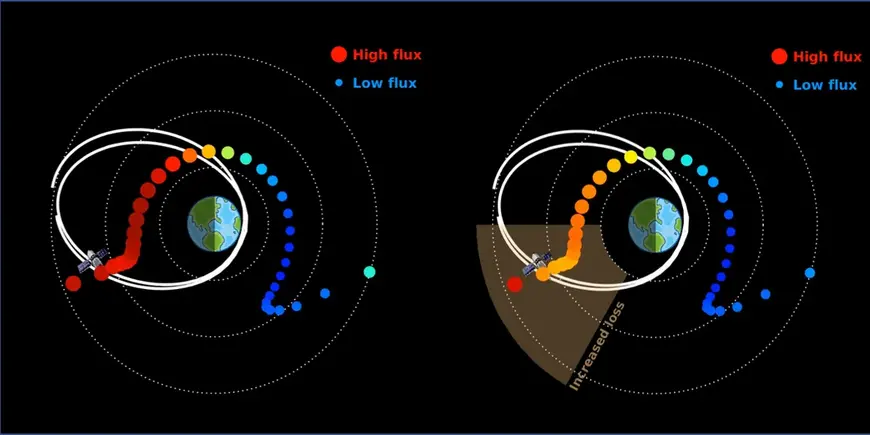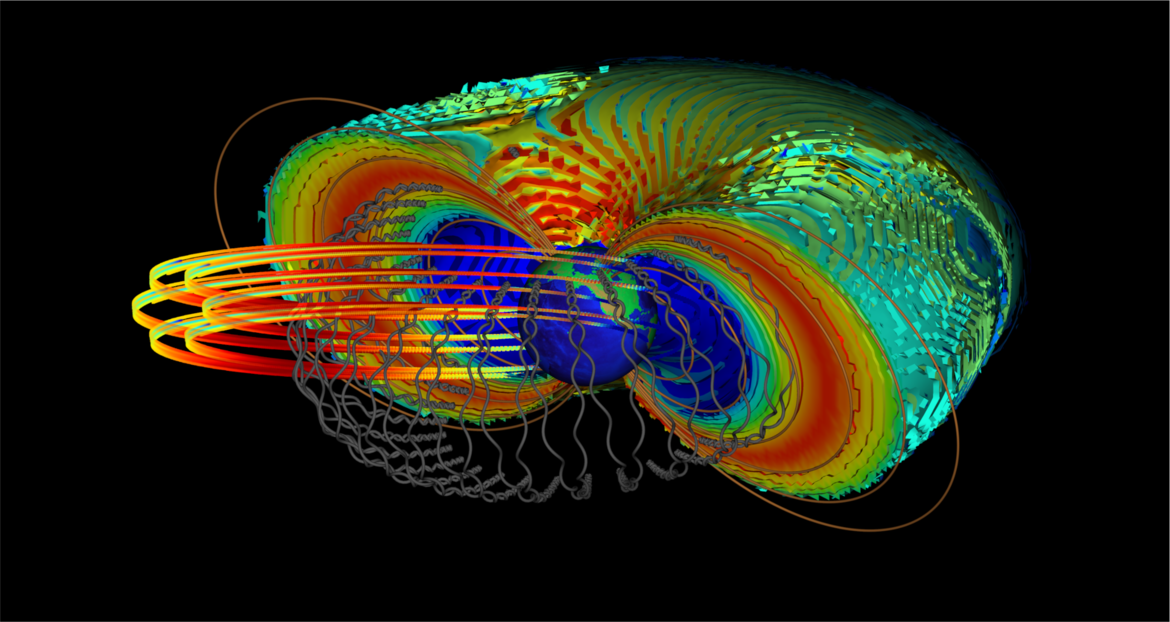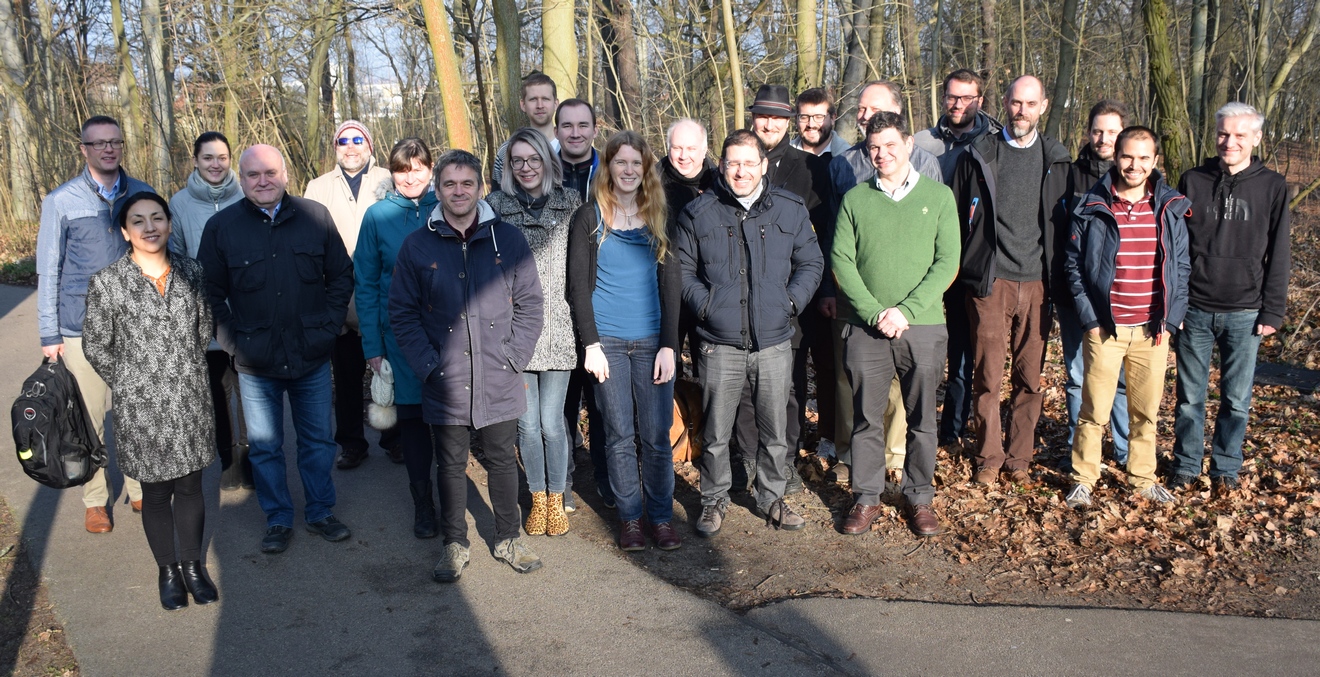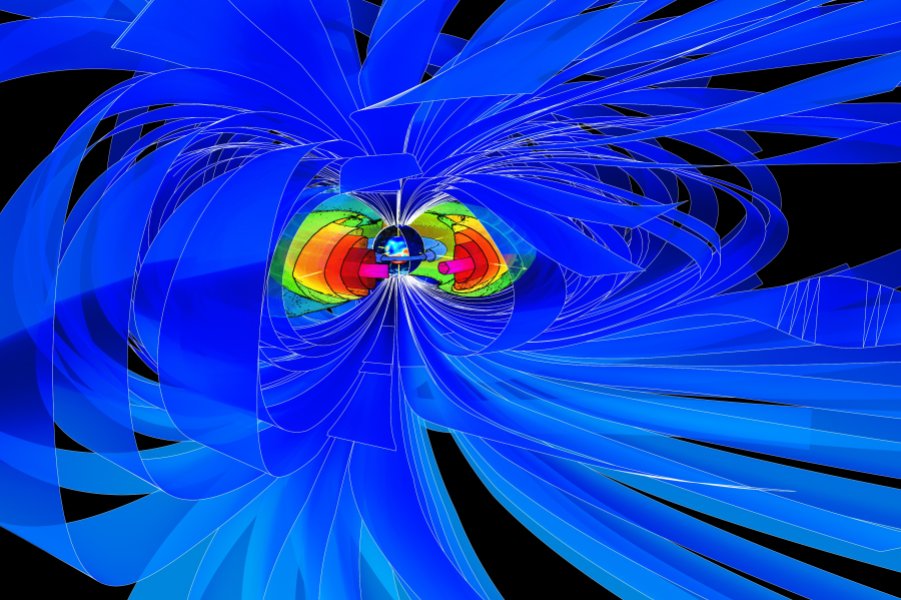VERB code at CCMC
You can request VERB code run at CCMC: https://ccmc.gsfc.nasa.gov/models/VERB-3D~2.5
Scientific Background and Model Scope
The Versatile Electron Radiation Belt (VERB) model has been described in Shprits et al., 2009, and Subbotin et al., 2010. It solves the Fokker-Planck equation for electron PSD [Schulz and Lanzerotti, 1974, Shprits et al., 2008b, Subbotin and Shprits, 2009]. The equation is solved using a finite differences approach and an implicit numerical scheme. Stability of such scheme is independent of the used time step. Following the approach used for the solution without mixed diffusion terms, described by Subbotin and Shprits[2009], the equation (1) is split into radial diffusion and local (energy, pitch angle, mixed) diffusion. The further separation of energy and pitch angle diffusion is impossible due to the existence of the mixed diffusion terms. Therefore, the implicit solution requires inversion of a model matrix of the 2-D operator on each time step. Inversion of such a big matrix is a quite time consuming computational operation, which is not required for the solution of the Fokker-Planck equation in the explicit formulation [Press et al., 1992]. However, the implicit scheme allows to use any time steps, while the time step in explicit scheme is limited by the Courant-Friedrichs-Lewy stability condition [Courant et al., 1928; Press et al., 1992], and the overall computational wall clock time with implicit scheme is lower.
First results were presented in Shprits et al., 2008a
Accuracy/Validation:
The long-term modelling results have a good agreement with observations for energetic and relativistic electrons (100 keV – ~1 MeV). The simulation has been run for L* from 1 to 7 and 1 to 5.5. The pitch angles were considered in the range from 0.3 up to 89.7 degrees, and energies were modeled from 10 keV to 10 MeV. Subbotin et al., 2011
- Subbotin, D. A., Y. Y. Shprits, B. Ni (2011), Long-term radiation belt simulation with the VERB 3-D code: Comparison with CRRES observations, J. Geophys. Res., 116, A12210, doi:10.1029/2011JA017019
- Drozdov, A., Y. Y. Shprits, K. G. Orlova, A. C. Kellerman, D. A. Subbotin, D. N. Baker, H. E. Spence, G. D. Reeves (2015), Energetic, relativistic, and ultrarelativistic electrons: Comparison of long-term VERB code simulations with Van Allen Probes measurements, J. Geophys. Res. Space Physics, 120, doi:10.1002/2014JA020637
The locations of the inner and outer edge of the outer radiation belt, and the location of peak flux in different models that include different scattering mechanisms were tested using the mean absolute percentage error during periods of different geomagnetic activity.
- Kim, K.-C., Y. Shprits, D. Subbotin, and B. Ni (2012), Relativistic radiation belt electron responses to GEM magnetic storms: Comparison of CRRES observations with 3-D VERB simulations, J. Geophys. Res. [Space Phys], 117(A8), doi:10.1029/2011JA017460
The VERB code was also used to model the dynamics of the specific event for ultra-relativistic electrons:
- Shprits, Y. Y., D. Subbotin, A. Y. Drozdov, M. E. Usanova, A. C. Kellerman, K. G. Orlova, D. N. Baker, D. L. Turner & K.-C. Kim (2013), Unusual stable trapping of the ultrarelativistic electrons in the Van Allen radiation belts, Nature Physics, doi:10.1038/nphys2760
Science Constraints and Extremes
The model works in the quasi-linear assumption. The model provides the solution of the Fokker-Planck equation. The simulation can be performed on 1-D, 2-D and 3-D mode with or without mixed terms. The different types of waves may be included lightning, anthropogenic transmitters, hiss, chorus, EMIC. The code currently uses precomputed local diffusion coefficients, though the code is capable to compute the field aligned diffusion coefficients number of the waves such as hiss, chorus on day and night side, EMIC, lightning whistlers and waves from the ground VLF transmitters. A dipole field approximation was used in the performed and published studies.
Operational Running and Computational Aspects
Operational Constraints
The code can be executed on Windows, MAC and Linux operation systems. The cron (or alternatives) can be used to run the code in automation regime. Currently the data assimilative code is run via cron on a Linux machine with no human intervention.
The MATLAB or Octave, and IDL are currently using to create inputs to the model and process the outputs. The model can be adjusted to run without MATLAB/Octave. The IDL, Python, Perl can be used as an alternative. The real-time forecast runs are executed via bash scripts, field models are run in MPI FORTRAN, and figures are plotted with MATLAB
To see the forecast navigate to: https://rbm.epss.ucla.edu/realtime-forecast/
Run Time:
The time of calculation depends on the number of the time steps, the size of the grid, and the type of simulation.
Fast simplified version runs at 10000 times faster than the wall clock. Years of real time will only take minutes.
One step of the typical 3-D simulation takes no more than 10 seconds. The one hour resolution is sufficient to provide reasonable results. The minute resolution can be used to increase the accuracy of specific event studies. The data assimilative code currently code takes 10-20 seconds per hourly time step, depending on the number of CPU’s available.
The code can be run on the regular PC. Long-term simulations may take several gigabytes of hard drive space, depending on the size of the grid and time resolution required. The code does provide the option to output files only at a desired interval to reduce the use of storage and to increase computation time.
Source Code Quality Assurance
The code is documented using the Doxygen system.
The SEMG maintains a Gitlab server, and Git is used to provide version control.
The input errors are checked during code operation. The output errors are displayed as warning and can be tracked with the generated log files.
The code has been run on Windows, MAC and Linux platforms. In addition the code has been executed on the Yellowstone, and UCLA supercluster.
The code is written on C++. The MATLAB scripts were written to support the code inputs and outputs. The data assimilative code runs in MATLAB and C++.
Maintenance
The code is supported by the Space Environment Modelling Group.
Any C++11 compatible compiler can be used to build the executable file. The MATLAB is optionally required.
The diffusion coefficients can be provided as external file or computed inside the code. Boundary conditions can provided as external files or set in the code setup file (e.g. Neumann boundary conditions).
Observations and Model Coupling to Other Models
Input Observations
The model may be driven by the observation from a single energy channel, however more sophisticated boundary conditions are possible (e.g. phase space density/full energy spectrum). The initial conditions can be setup from the observations or modelled inside the code. Only Kp index of geomagnetic activity is required.
The observations are obtained from any available spacecraft, usually those crossing the boundary conditions. The simulation can be operated in the realtime mode in the time scale of minutes, however the hourly average data is sufficient to provide reasonable results.
- Subbotin, D. A., and Y. Y. Shprits (2009), Three‐dimensional modeling of the radiation belts using the Versatile Electron Radiation Belt (VERB) code, Space Weather.
We have not identified any input conditions that critically reduce the quality of the model output, however one should ensure that the upper boundary conditions are data driven during dynamic times.
Input Model Data
The VERB code uses modelled radial diffusion coefficient:
- Brautigam, D. H., and J. M. Albert (2000), Radial diffusion analysis of outer radiation belt electrons during the October 9, 1990, magnetic storm, J. Geophys. Res., 105(A1), doi:10.1029/1999ja900344
- Ozeke, L. G., I. R. Mann, K. R. Murphy, I. J. Rae, D. K. Milling, S. R. Elkington, A. A. Chan, and H. J. Singer (2012), ULF wave derived radiation belt radial diffusion coefficients, J. Geophys. Res. [Space Phys], 117(A4), doi:10.1029/2011JA017463
Statistically based models of local diffusion coefficients:
- Orlova, K. G., Y. Y. Shprits, and B. Ni (2012), Bounce-averaged diffusion coefficients due to resonant interaction of the outer radiation belt electrons with oblique chorus waves computed in a realistic magnetic field model, J. Geophys. Res. [Space Phys], 117(A7), doi:10.1029/2012JA017591
- Orlova, K., M. Spasojevic, and Y. Shprits (2014), Activity-dependent global model of electron loss inside the plasmasphere, Geophys. Res. Lett., 41(11), 3744–3751.
Plasma pause location:
- Carpenter, D. L., and R. R. Anderson (1992), An ISEE/whistler model of equatorial electron density in the magnetosphere, J. Geophys. Res. [Space Phys], 97(A2), 1097–1108.
Magnetopause location:
- Su, Z., F. Xiao, H. Zheng, and S. Wang (2011), CRRES observation and STEERB simulation of the 9 October 1990 electron radiation belt dropout event, Geophys. Res. Lett., 38(6), doi:10.1029/2011GL046873
Outer radial boundary condition may be driven from the output of an empirical Geosynchronous flux model.
- Kellerman, A. C., Y. Y. Shprits, and D. L. Turner (2013), A Geosynchronous Radiation‒belt Electron Empirical Prediction (GREEP) model, Space Weather, 11, 463–475, doi:10.1002/swe.20074
This is currently used for the real-time radiation belt forecast
The outer radial boundary and lower energy boundary may be driven by a convection model. A one way coupling was established the RICE Convection Model (RCM).
- Subbotin, D. A., Y. Y. Shprits, M. Gkioulidou, L. R. Lyons, B. Ni, V. G. Merkin, F. R. Toffoletto, R. M. Thorne, R. B. Horne, and M. K. Hudson (2011), Simulation of the acceleration of relativistic electrons in the inner magnetosphere using RCM-VERB coupled codes, J. Geophys. Res. [Space Phys], 116(A8), doi:10.1029/2010JA016350
Output Model Data
Several data assimilative models have been developed and tested.
- Ni, B. , Y. Y. Shprits, R. Thorne, R. Friedel, T. Nagai (2009), Reanalysis of relativistic radiation belt electron phase space density using multisatellite observations: Sensitivity to empirical magnetic field models, J. Geophys. Res., 114, A12208, doi:10.1029/2009JA014438
- Daae, M., Y. Y. Shprits, B. Ni, J. Koller, D. Kondrashov, Y. Chen (2011), Reanalysis of radiation belt electron phase space density using various boundary conditions and loss models, Advances in Space Research, Vol. 48, Issue 8, p.1327-1334.
- Kondrashov, D., Y. Shprits, M. Ghil, and R. Thorne (2007), A Kalman filter technique to estimate relativistic electron lifetimes in the outer radiation belt, J. Geophys. Res. [Space Phys], 112(A10).
- Shprits, Y., D. Kondrashov, Y. Chen, R. Thorne, M. Ghil, R. Friedel, and G. Reeves (2007), Reanalysis of relativistic radiation belt electron fluxes using CRRES satellite data, a radial diffusion model, and a Kalman filter, J. Geophys. Res. [Space Phys], 112(A12), doi:10.1029/2007JA012579
- Shprits, Y. Y., M. Daae, B. Ni (2012), Statistical Analysis of Phase Space Density Buildups and Dropouts, J. Geophys. Res., 117, A01219,doi:10.1029/2011JA016939
The data-assimilative VERB code couples 3-D model output with multiple spacecraft observations and a Kalman filer using the split-operator method.
- Shprits, Y., A. Kellerman, D. Kondrashov, and D. Subbotin (2013), Application of a new data operator-splitting data assimilation technique to the 3-D VERB diffusion code and CRRES measurements, Geophys. Res. Lett., 40(19), 4998–5002.
- Kellerman, A. C., Y. Y. Shprits, D. Kondrashov, D. Subbotin, R. A. Makarevich, E. Donovan, and T. Nagai (2014), Three-dimensional data assimilation and reanalysis of radiation belt electrons: Observations of a four-zone structure using five spacecraft and the VERB code, J. Geophys. Res. [Space Phys], 119(11), 8764–8783.
This framework is also used to produce a real-time forecast of the electron radiation belts. http://rbm.epss.ucla.edu/realtime-forecast/
VERB code and observation errors have also been estimated to drive a data-assimilative model.
- Podladchikova, T. V., Y. Y. Shprits , D. Kondrashov , A. C. Kellerman, Noise statistics identification for Kalman filtering of the electron radiation belt observations I: Model errors, J. Geophys. Res: Space Physics, Volume 119, Issue 7, pages 5700–5724, July 2014, doi:10.1002/2014JA019897
- Podladchikova, T. V., Y. Y. Shprits , A. C. Kellerman, D. Kondrashov, Noise statistics identification for Kalman filtering of the electron radiation belt observations II: Filtration and smoothing (2014), J. Geophys. Res.: Space Physics, Volume 119, Issue 7, pages 5725–5743, July 2014, doi:10.1002/2014JA019898
The VERB code was used with NARMAX to create the VNC forecast model.
- Pakhotin, P., A. Y. Drozdov, Y. Y. Shprits, R. J. Boynton, D. Subbotin, and M. A. Balikhin (2014), Simulation of high-energy radiation belt electron fluxes using NARMAX-VERB coupled codes, J. Geophys. Res. [Space Phys], doi:10.1002/2014JA020238
- http://www.ssg.group.shef.ac.uk/USSW/3h_2MeV_EF.html
Sustainability of the model as an operating system
Support – Ongoing NASA, NSF support
Evolution – VERB4D
- Subbotin, D. A., and Y. Y. Shprits (2009), Three-dimensional modeling of the radiation belts using the Versatile Electron Radiation Belt (VERB) code, Space Weather, 7(10), S10001.
- Shprits, Y. Y., D. Subbotin, and B. Ni (2009), Evolution of electron fluxes in the outer radiation belt computed with the VERB code, J. Geophys. Res. [Space Phys], 114(A11), doi:10.1029/2008JA013784.
- Subbotin, D. A., Y. Y. Shprits, M. Gkioulidou, L. R. Lyons, B. Ni, V. G. Merkin, F. R. Toffoletto, R. M. Thorne, R. B. Horne, and M. K. Hudson (2011), Simulation of the acceleration of relativistic electrons in the inner magnetosphere using RCM-VERB coupled codes, J. Geophys. Res., 116(A8), A08211, doi:10.1029/2010JA016350.
- Shprits, Y., D. Subbotin, B. Ni, R. Horne, D. Baker, and P. Cruce (2011), Profound change of the near-Earth radiation environment caused by solar superstorms, Space Weather, 9(8), S08007, doi:10.1029/2011SW000662.
- Kim, K.-C., and Y. Shprits (2013), Long-term relativistic radiation belt electron responses to GEM magnetic storms, J. Atmos. Sol. Terr. Phys., 100–101(0), 59–67, doi:10.1016/j.jastp.2013.04.007.
- Shprits, Y., A. Kellerman, D. Kondrashov, and D. Subbotin (2013), Application of a new data operator-splitting data assimilation technique to the 3-D VERB diffusion code and CRRES measurements, Geophys. Res. Lett., 40(19), 4998–5002, doi:10.1002/grl.50969.
- Drozdov, A. Y., Y. Y. Shprits, K. G. Orlova, A. C. Kellerman, D. A. Subbotin, D. N. Baker, H. E. Spence, and G. D. Reeves (2015), Energetic, relativistic, and ultrarelativistic electrons: Comparison of long-term VERB code simulations with Van Allen Probes measurements, J. Geophys. Res. [Space Phys], 120(5), 3574–3587, doi:10.1002/2014JA020637.




